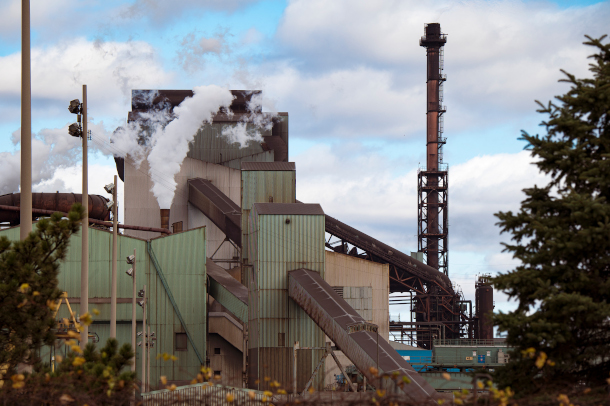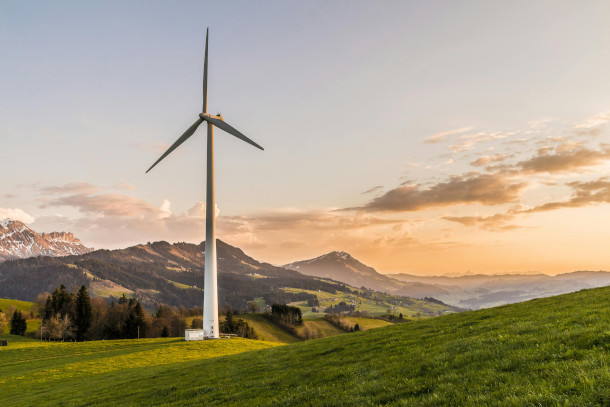Hot Battery Tech
Air Date: Week of May 31, 2024

Heavy industry like steel making requires vast amounts of heat. Thermal batteries powered by renewable electricity could store that heat and help decarbonize the industry. (Photo: michael_swan, Flickr, CC BY ND 2.0)
Carbon-intensive industries like steel and chemical manufacturing require a lot of heat to operate, most of which comes from burning fossil fuels. Now engineers are working on turning electricity from renewable sources into heat with something called a thermal battery. Inside Climate News reporter Phil McKenna joins Host Aynsley O’Neill to explain how the technology works and plans for commercial-scale deployment.
Transcript
DOERING: It’s Living on Earth. I’m Jenni Doering.
O’NEILL: And I’m Aynsley O’Neill. Nearly a quarter of greenhouse gas emissions in the United States come from heavy industry, like steelmaking or chemical plants. Those sectors require lots of heat to operate, and most of that heat right now comes from burning fossil fuels. To help decarbonize these sectors, engineers are working on turning electricity from renewable sources into heat with something called a thermal battery. The technology is still in development, but to get an idea of how it might work, Inside Climate News reporter Phil McKenna paid a visit to a startup that’s putting its design to the test. He’s here to tell us more. Phil, welcome back to Living on Earth!
MCKENNA: Thanks for having me.
O'NEILL: So Phil, walk us through the concept of a thermal battery. What is this technology, and what would a thermal battery be used for?
MCKENNA: A thermal battery is something that can simply hold heat, hold a lot of heat, ideally at really high temperatures. So thermal batteries are something that would be incredibly helpful for decarbonizing heavy industry. So anything from steel manufacturing, cement manufacturing, chemical plants, food processing, all of these industrial facilities need a tremendous amount of heat. And right now that heat comes from burning things, typically natural gas, or coal, other fossil fuels, all just to generate the heat that's needed to run those industrial processes.
O'NEILL: So Phil, we already have, you know, various forms of clean energy, solar, wind, how does a thermal battery fit into that broader landscape of clean energy?
MCKENNA: So the key challenge at the moment for renewables is not better solar, better wind—the price of both of those has really, really fallen. The key challenge now is finding batteries that can store that energy until it's needed, until when the sun doesn't shine or the wind isn't blowing. So having a technology like this, that can convert electricity to really high temperature heat, store that heat until it's needed, is really a potential game changer.

One of the challenges of the clean energy market is finding ways to store electricity generated from intermittent renewable sources. Thermal batteries present one solution. (Photo: Pixabay, Pexels)
O'NEILL: And so you recently looked into a startup called Electrified Thermal Solutions, and they have their own proprietary thermal battery design, the Joule Hive. What sets their design apart from other concepts of a thermal battery?
MCKENNA: Everybody's trying to figure out batteries, energy storage, whether it's heat or electricity. What really sets this company apart is that they're doing it with commercially available materials, allowing them to do it very cheaply and at large scale. So there are a lot of electric heaters that will use wires or some exotic materials that allow them to make things really hot. But those are often very expensive. There are a lot of heaters that work very well at lower temperatures, like the radiators in your toaster oven. But if you try to do them at very high temperatures, the temperatures that industries need, they will quickly burn out. So Electrified Thermal Solutions uses fire bricks, essentially the bricks that are in a fireplace or an industrial kiln, really common materials. What they have done is then taken common bricks that we use, and they have tweaked the recipe ever so slightly, so that these bricks which normally would not conduct electricity, now conduct electricity. They take in the electricity and they convert it to heat, they radiate that heat out much in the same way that your toaster oven is an electric heater, it turns bright, hot red that radiates the heat, the electricity to toast your bread. So what they have found and what sets them apart is they have found materials that are very inexpensive and are very robust, can handle really high temperature heat and store that heat until it's needed.
O'NEILL: Alright, this thermal battery, the Joule Hive, how much heat can it store and for how long? How does it compare to what's needed at industrial scale?
MCKENNA: So the Joule Hive can store electricity up to 1800 degrees Celsius, that's hotter than the temperature of melting steel. And it can store that heat for up to several days, which would be far longer than any industrial facility would likely need.
O'NEILL: So they have this concept, and they have proof of concept. But to what extent are thermal batteries on their way to becoming commercially available? You know, where does this technology stand in the process of actually being implemented in the world at large?
MCKENNA: So this company is still very much a startup. They do not yet have a commercial scale battery. But that said, they have recently received two federal grants from the U.S. Department of Energy that allow them to scale up, and allow them to do that much more quickly than they otherwise would have been able to. The first $5 million grant that they got earlier this year allows them to build their first commercial-scale pilot project at a testing facility in San Antonio, Texas. And the second grant that they received in March, up to $35 million in federal funding, allows them to build their first commercial Joule Hive battery or set of batteries at a chemical plant in Kentucky. The plant is owned by a chemical company called Ashland, and it's a very large chemical plant that is powered entirely by steam. They need a lot of high-temperature steam. And right now they get that by burning natural gas. And what this grant will allow is for them to swap out that heat generation, swap out the natural gas with these electric-powered Joule thermal batteries, essentially replacing burning fossil fuels with clean electricity to generate that steam.
O'NEILL: Alright, so this is being implemented in Kentucky. There must already be a utilities provider down there. What's their reaction been to this technology?

Phil McKenna is a reporter for our partner, Inside Climate News. (Photo: Laura Ellis)
MCKENNA: I spoke with the Tennessee Valley Authority. That's the local utility for Calvert City. And they were ecstatic about this technology and about this project. For them, they face a tremendous challenge in that a lot of industries are seeking to decarbonize, looking to electrify, and that's going to put a tremendous strain on their already strained electric grid. They'll need to build out more capacity so they have enough electricity at periods of peak demand. What they really like about this thermal battery is that Electrified Thermal Solutions can draw electricity at periods of off-peak demand when not a lot of people need electricity, charge up their batteries then, so that they're not drawing at peak periods when, when other people need it.
O'NEILL: And so what kind of impact would these batteries have on the chemical plant where they're being tested? You know, how much would they actually reduce when it comes to greenhouse gas emissions?
MCKENNA: In their grant award, the DOE said that this would reduce greenhouse gas emissions from steam generation at the plant by 70%. The bigger picture is that about a quarter of all greenhouse gas emissions in the U.S. come from industrial facilities like this chemical plant, and if the way they generate heat at these facilities is replaced, the fossil fuels are replaced with thermal batteries, they figure that they could reduce greenhouse gas emissions from all industry by about 50%.
O'NEILL: Phil McKenna is a reporter with our partner Inside Climate News. Phil, thank you so much for taking the time with me today.
MCKENNA: Thanks for having me.
Links
Inside Climate News | “The Race to Decarbonize Heats Up”
Living on Earth wants to hear from you!
Living on Earth
62 Calef Highway, Suite 212
Lee, NH 03861
Telephone: 617-287-4121
E-mail: comments@loe.org
Newsletter [Click here]
Donate to Living on Earth!
Living on Earth is an independent media program and relies entirely on contributions from listeners and institutions supporting public service. Please donate now to preserve an independent environmental voice.
NewsletterLiving on Earth offers a weekly delivery of the show's rundown to your mailbox. Sign up for our newsletter today!
 Sailors For The Sea: Be the change you want to sea.
Sailors For The Sea: Be the change you want to sea.
 The Grantham Foundation for the Protection of the Environment: Committed to protecting and improving the health of the global environment.
The Grantham Foundation for the Protection of the Environment: Committed to protecting and improving the health of the global environment.
 Contribute to Living on Earth and receive, as our gift to you, an archival print of one of Mark Seth Lender's extraordinary wildlife photographs. Follow the link to see Mark's current collection of photographs.
Contribute to Living on Earth and receive, as our gift to you, an archival print of one of Mark Seth Lender's extraordinary wildlife photographs. Follow the link to see Mark's current collection of photographs.
 Buy a signed copy of Mark Seth Lender's book Smeagull the Seagull & support Living on Earth
Buy a signed copy of Mark Seth Lender's book Smeagull the Seagull & support Living on Earth

